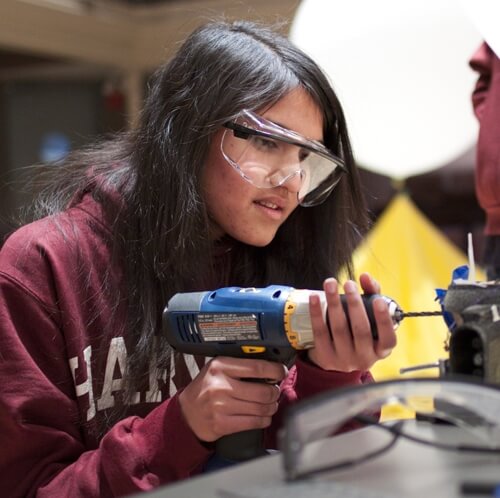News
Lakshmi Parthasarathy '12, a computer science concentrator, creates a hole for a valve that will allow her group to add extra helium to a giant, tent-supporting balloon.
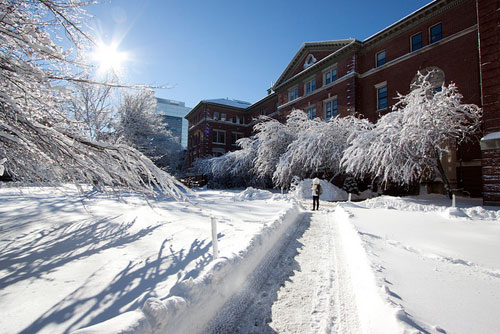
Serene, but not sleepy. Oxford Street was a hive of activity this January, thanks to an array of optional workshops in science writing, rapid prototyping, microscopy, MATLAB, and much more.
Though the wind was howling and the snow in Harvard Yard piled first to the knees and then to the waist, students at the Harvard School of Engineering and Applied Sciences (SEAS) this January braved the cold to pursue their passions.
Faculty and staff hosted more than a dozen workshops during Harvard's Optional Winter Activities Week, on topics as varied as computer-aided design, machining, science writing, MATLAB and Mathematica, X-ray imaging and micro-CT, and electron microscopy. One workshop even involved designing and building a 900-square-foot tent suspended from helium balloons.
Machine Shop Class / Introduction to Rapid Prototyping
The Machine Shop and Undergraduate Teaching Labs hosted workshops over several days to introduce graduate students at SEAS and at the Graduate School of Arts and Sciences (GSAS) to the software and machinery used for designing and building prototypes.
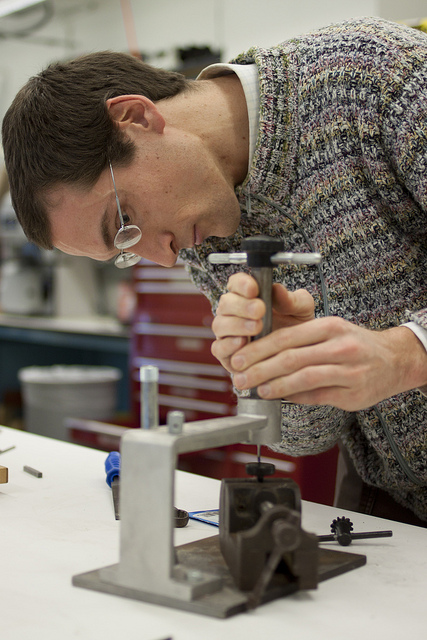
Giovanni Berlanda, a postdoctoral researcher who collaborates with the instructional labs at SEAS, used traditional machine shop equipment for part of the motor.
Using SolidWorks modeling software, a laser cutter, a 3D printer, and some more traditional machine shop equipment, students designed, produced, and assembled custom parts for simple motors that can be used in an engineering course this semester.
According to Joe Ustinowich, Engineering Associate for the teaching labs, the fast-fabrication process allowed the students to move from design to product in a matter of hours, in keeping with today's industrial trends.
"Things change on literally an hourly basis now," he said. "How many times do you have a new telephone come out each month?"
Students finished the workshops well versed in both design processes and techniques.

This circular part was created using a laser cutter.
Writing Science
Cornelia Dean, former science editor at The New York Times, led a three-week workshop designed to help graduate students learn to distill complex scientific ideas into "clear, concise, and engaging prose."
Through discussions, in-class writing exercises, and longer profile and op-ed assignments, students gained valuable experience writing about their work for a general audience.
"Science writing is really important to people professionally, but also for communicating to the public," said Rosalind Reid, Assistant Dean for External Programs at SEAS, who arranged for the workshop to take place through a collaboration with the Harvard University Center for the Environment (HUCE).
Computefest
Reid is also Executive Director of the recently created Institute for Applied Computational Science (IACS) at SEAS, which hosted Computefest in January.
IACS brought in specialists from Mathworks, Woldfram Research, and the office of Instructional and Research Computing Services at SEAS to hold workshops and seminars on a variety of aspects of MATLAB and Mathematica.
"The thought is that we should give students a chance to experience these tools before they start the semester, so that they can roar along when they're doing computational courses," said Reid.
Over the course of four days, the workshops progressed in rigor from basic overviews of the software to more advanced applications like parallel computing, and symbolic and numeric computation and visualization.
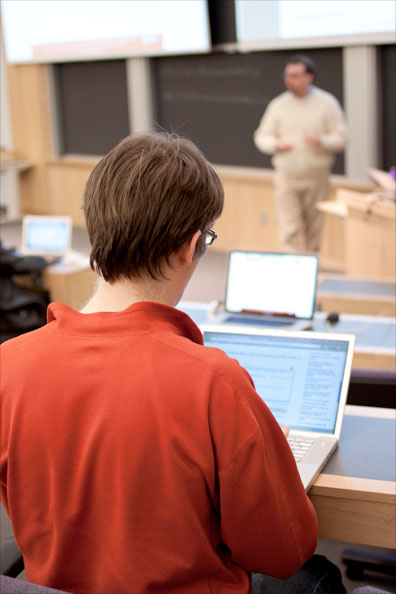
Lars Kellogg-Stedman, a Senior Technologist in SEAS' Office of Information Technology, attended a hands-on workshop on parallel computing.
"We've had a huge influx of interest," Reid said, "not just from SEAS students, but students from other disciplines, because these [programs] are used in engineering and all of the sciences. We're experimenting with giving them really hands-on instruction in the tools so that they can be really successful in their courses."
Large-Scale, Rapid-Deployment Disaster Relief Shelter
Conventional buildings use walls or columns to support the weight of the structure, through compression, but is it possible to do the opposite? How would an engineer design a building that was supported by balloons floating overhead?
A week-long design project that was inspired by disaster relief efforts after last year's earthquake in Haiti—as well as an interesting physics problem—provided Harvard undergraduates with the opportunity to address these questions.
Freshman Dani Ithier '14 was quick to sign up for the project. Having participated in the FIRST robotics program in high school, she now plans to concentrate in mechanical engineering.
"I've only had a semester's worth of classes so far, and a lot of it's just theory, so I wanted to get my hands dirty," she said.
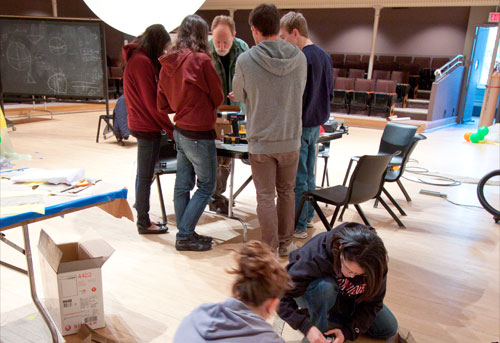
Lecturer Barry Griffin '71 (back center) discussed the final stages of the project with a group of undergraduates. Ellen Farber '13 (front left) and Dani Ithier '14 (front right) pinned together fabric strips to create a large net that would harness one helium balloon.
The curiosity about balloon-supported structures was born out of a senior project by Dan Nevius '11, for the course ES 100, "Engineering Design Projects." Nevius' project involved designing a giant 3D printer for NASA that would, theoretically, build large structures on the moon. The printer would be supported by tower-like legs; however, in conversations with faculty and staff at SEAS, the concept gradually morphed into something else.
What if the legs were flexible instead of rigid? What if the machine could walk around like a spider, collecting debris?
What the structure wasn't supported by legs at all, but by balloons?
Balloons, they thought, could be used to rapidly deploy a lightweight disaster relief shelter. The tent would be safe, simple, adaptable, and cheap.
So about a dozen students found themselves brainstorming, designing, sewing, and drilling; gathering trash barrels for weight; and concocting last-minute engineering solutions.
"The key idea on how to anchor this came from someone who's not even an engineer, at lunch an hour ago," said Griffin.
The team is now waiting for a clear, calm day to deploy the shelter.
The workshop was enabled by Harvard President Drew Faust's January Innovation Fund. For more information on the project, see the Harvard Gazette.
Microscopy and Imaging
The Center for Nanoscale Systems hosted two workshops this winter. The Electron Microscopy Workshop combined a lecture-style introduction to theory and principles with a hands-on session in the LISE imaging suites.
Introduction to X-ray Imaging and Micro-CT similarly walked students through the theory and practice of X-ray generation and imaging techniques.
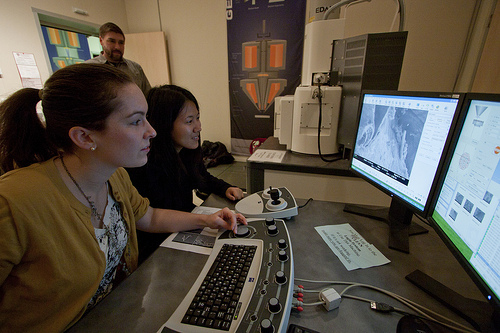
HackHarvard
A collaboration between the Technology and Entrepreneurship Center at Harvard (TECH), Computer Science 50: “Introduction to Computer Science I," and the Undergraduate Council, HackHarvard served as an incubator for a group of about 10 CS50and undergraduate council projects.
The Crimson was there and offered coverage of "the crop of applications" that came out of the intense spurt of brainstorming and coding.
Topics: Computer Science
Cutting-edge science delivered direct to your inbox.
Join the Harvard SEAS mailing list.
